“Fragments of Life: Textile Art by Barbara Goldberg” Review by Catherine Hunter
July 12, 2017
Barbara Goldberg was an artist, teacher and advocate for textile arts. While her resume flows over ten pages with honors, national and international exhibitions, and publications, she is especially remembered as a devoted faculty member in Textile Design and Fiber Arts at UMass Dartmouth. Colleagues and students describe her as unconventional, no nonsense, feisty, and intellectually curious.
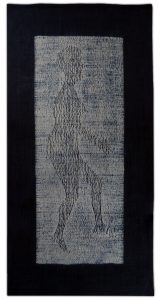
Barbara Goldberg Self-portrait I 1992, shibori on indigo-dyed linen, 100” x 52″. Photo: Joe Ofria.
Fragments of Life: Textile Art by Barbara Goldberg has 34 textiles and is both a retrospective and a memorial, since Goldberg died in 2016. The 40-page color catalog will continue to nourish readers with a vibrant portfolio of textiles and text by Goldberg and six contributing authors.
The exhibition presents Goldberg’s insatiable exploration of resist dyeing, motifs and color over five decades, from the 1960s to 2000s. There are examples of a dozen techniques with emphasis on her passion for Japanese shibori and indigo.
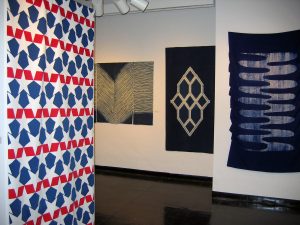
Fragments of Life installation shot (works left to right): Glory Be, Screen, Banner, and Water. Photo: Viera Levitt.
In the following artist’s statement, the curators found the exhibition title: “This work is in the Japanese resist technique called shibori, which involves manipulating and securing cloth into three-dimensional shapes which then produce patterns when the cloth is dyed. After the bindings are removed, a record of the manipulation and shape remains in the resulting imagery. This ‘recording’ of the process of patterning with its many variations and interpretations is, for me, symbolic of the patterns and interruptions of patterns in life—an ordering, albeit imperfect, of the fragments of life.”
Visitors to the gallery come face-to-face with Goldberg in two life-size shibori silhouettes. In Self-Portrait I (1992) she strides forward. In Self-Portrait II (2004) she has turned with cane in hand to face her younger self. As textiles embody her creative, expressive and generous life, it is fitting that Goldberg created self-portraits in shibori. These pieces are planned gifts by the Barbara Goldberg Estate to the Museum of Fine Arts, Boston.
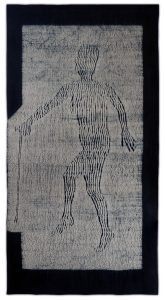
Barbara Goldberg Self-portrait II 2004, shibori on indigo-dyed linen, 97” x 52”. Photo: Joe Ofria.
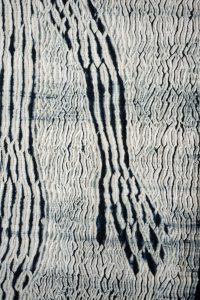
Barbara Goldberg Self-portrait II (detail) 2004, shibori on indigo-dyed linen, 97” x 52”. Photo: Joe Ofria.
Footprints (2001) lovingly preserves the footprints of five grandchildren in shibori. The theme of protection echoes because textiles, family and the methodology evoke the idea of protection. (Shibori uses compression to ‘resist’ dye; however, one can also say that compression ‘protects’ fabric from the dye bath.)

Barbara Goldberg Footprints 2001, shibori on indigo-dyed silk, 102” x 14.5″. Photo: Joe Ofria.
Water (1982) is a serpentine channel of water-like textures that flows down a saturated indigo fabric panel that ripples in shallow waves. Goldberg loved the ocean, the watery bath of blue dye, the water-like texture of shibori. She describes a visit to the sea as a “symbolic and literal return to the source of life for spiritual and physical renewal.”
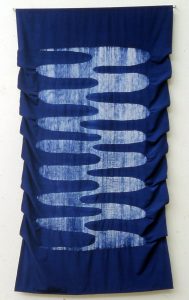
Barbara Goldberg Water 1982, shibori on indigo-dyed rayon, 82” x 45”. Photo by the artist.
D.T. Squared (1983) appears to be a series of 12 rectangular cloths each with variations of shibori in a 10 inch square. In fact, the series was a protest 34 years ago when fiber arts were competing to be accepted. The rectangles are dish towels that represent textiles as a traditional medium for women; the shibori represents artistic expression. Goldberg’s advice to her students was serious and playful: “I have been questioned about the practical use of my work, the assumption being that it cannot be considered ‘real art,’ and must have only functional and/or decorative value. This piece is my humorous dismissal to that tiresome mentality. Nothing could be more practical than dish towels! The title, ‘D.T. Squared’, is a private pun.”
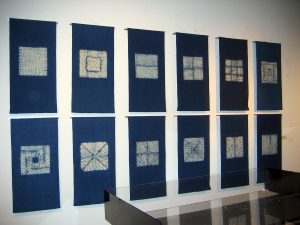
Barbara Goldberg D.T. Squared (installation) 1983, shibori on indigo-dyed linen. Photo: Joe Ofria.
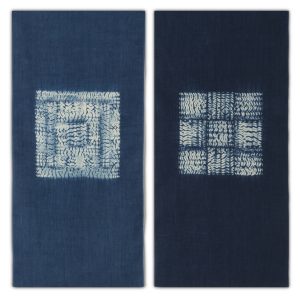
Barbara Goldberg D.T. Squared (detail) 1983, shibori on indigo-dyed linen. Photo: Joe Ofria.
Finally, Goldberg was a tenacious advocate in the textile arts community as a member of the Surface Design Association, Textile Society of America, World Shibori Network and the Brandford/Elliott Award Board. Goldberg’s friendship with Brandford inspired one artwork in the exhibition.
Remembering Joanne (2004) is a tribute to Goldberg’s first textile history teacher, mentor and friend Joanne Segal Brandford, a pioneer in fiber art who introduced Goldberg to surface design. This surprising assemblage of plastic netting (recycled food storage bags) resembles an ancient Peruvian textile with tie-dye diamonds (painted to imitate tie-dye), possibly the earliest example of resist dyeing in the world.
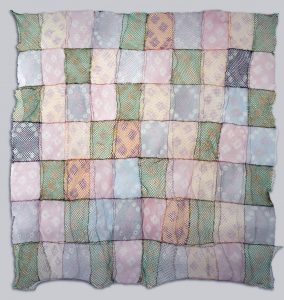
Barbara Goldberg Remembering Joanne 2004, painted plastic netting, 70” x 60″. Photo: Joe Ofria.
Following the deaths of Brandford and Lillian Elliott in 1994, Goldberg was one of the founders of the Brandford/Elliott Award for Excellence in Fiber Art that will continue to be awarded by the Textile Society of America.
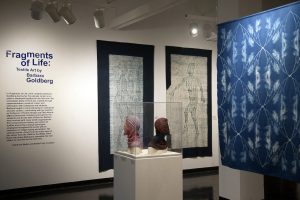
Fragments of Life installation shot (works left to right): Peacock Casque, Rosie’s Casque, Self-portrait I, Self-portrait II, Duplex Blues. Photo: Viera Levitt.
This exhibition superbly introduces visitors to an artist who discovered and expressed joy in life and the creative process of textile design and fiber arts.
– Catherine Hunter, Independent Museum Consultant
Fragments of Life: Textile Art by Barbara Goldberg
– University Art Gallery, New Bedford, MA
– College of Visual and Performing Arts, University of Massachusetts Dartmouth
– May 26 to July 16, 2017
– Co-curated by Catherine Weller, Independent Curator and Artist, and Noelle Foye, Director of the New Bedford Art Museum.

Related Blog Articles
No related blog articles yet.